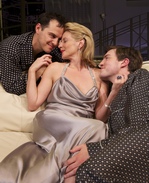SITE GUIDE
SEARCH
REVIEWS
REVIEW ARCHIVES
ADVERTISING AT CURTAINUP
FEATURES
NEWS
Etcetera and
Short Term Listings
LISTINGS
Broadway
Off-Broadway
NYC Restaurants
BOOKS and CDs
OTHER PLACES
Berkshires
London
California
New Jersey
DC
Connecticut
Philadelphia
Elsewhere
QUOTES
TKTS
PLAYWRIGHTS' ALBUMS
LETTERS TO EDITOR
FILM
LINKS
MISCELLANEOUS
Free Updates
Masthead
Writing for Us
A CurtainUp  London Review
London Review
 London Review
London ReviewDesign for Living
|
I enjoy meeting new people too but not second hand ones. — Gilda
|

Andrew Scott as Leo, Lisa Dillon as Gilda and Tom Burke as Otto (Photo: Manuel Harlan) |
It may be the closest Coward wrote to an autobiographical play with its allusion to men who are homosexual but who also have a sexual relationship with a woman. There is a fascinating article in the theatre programme about Coward and the acting couple the Lunts, Alfred Lunt and his wife Lynn Fontanne, who were all in the original Broadway production of 1933. Back across the Atlantic, because of the Lord Chamberlain's defence of "public decency", Design for Living was banned from the London stage for a further six years.
Coward is not for those who like their comedy natural and unmannered. It is all terribly, terribly refined with these spoilt, rich, affected people whose lives are almost never touched by the working classes except when it is to laugh at the incompetent efforts of a maid to answer the telephone or the stupidity of a newspaper hack. But Coward is also very, very witty, with clever insights into human behaviour and an ability to laugh at himself is ever present. The butt of much of the humour in Design for Living is Ernest, the conventional stuff shirt who represents society's condemnation of unusual living arrangements. Ernest is the only grown up in the cast of the four main characters.
Andrew Scott is, as ever, in fine form as Leo ,the character closest to Coward's own. Sometimes peevish, sometimes bitchy, he always makes us smile. Every moment Scott is onstage is delightful with a subtle range of mannerisms combined with audacious, witty remarks and brilliant expression.
Act Three which is for me the most enjoyable has great chemistry with Leo and Otto, both having borrowed Ernest's exquisite black patterned silk pyjamas, as a mischievous double act bouncing camp humour off each other like a pair of naughty schoolboys let loose on the American victims or ridiculous Ernest. Tom Burke seems to really enjoy playing Otto in this act. Lisa Dillon's Gilda is mostly a foil for this sparkling but shallow pair but she acts very well when she is called upon to be deceptive and jittery, always a difficult situation to convey. What is interesting is that Gilda does not seem to hold the balance of power in this triangle as the bond between the men seems stronger than the heterosexual one. Gilda's critique of the play is fun and shows her incisive analytical ability but too often Lisa Dillon doesn't convince.
My reservations are in Act Two when Otto and Leo kiss while they are drunk. The sexual attraction, the bond between these men shouldn't need an excess of alcohol to find its expression and the directorial choice to make this as a result of complete inebriation is one I find questionable. Of course although it is very funny to see these two acting being legless, the price paid is to gloss over the homosexuality with the cozy explanation of drunkenness. I also wondered where the cocaine was!
Lez Brotherston's design is sumptuous with three excellent and detailed sets and glorious Thirties costume with evening dress and diamonds in the final act. I find this one of Noël Coward's plays a masterpiece of fine construction as characters build and plots develop so that I can forgive him for concentrating on these social butterflies. This is overall a very fine production of Design for Living and not to be missed.
|
Subscribe to our FREE email updates with a note from editor Elyse Sommer about additions to the website -- with main page hot links to the latest features posted at our numerous locations. To subscribe,
E-mail: esommer@curtainup.comesommer@curtainup.com
put SUBSCRIBE CURTAINUP EMAIL UPDATE in the subject line and your full name and email address in the body of the message -- if you can spare a minute, tell us how you came to CurtainUp and from what part of the country. |
| Design for Living
Written by Noël Coward Directed by Starring: Andrew Scott, Tom Burke, Lisa Dillon, Angus Wright With: Nancy Crane, Edward Dede, Matthew Gammie, John Hollingworth, Maggie McCarthy, Maya Wasowicz Design: Lez Brotherston Lighting: David Hersey Sound: Paul Groothuis Sponsored by Bank of America, Merrill Lynch and American Airlines Running time: Two hours 55 minutes with two intervals. Box Office: 0844 871 7609 Booking to 27th November 2010 Reviewed by Lizzie Loveridge based on 20th September 2010 performance at the Old Vic, Waterloo Road, London SE1 8NB (Rail/Tube: Waterloo) |
|
REVIEW FEEDBACK Highlight one of the responses below and click "copy" or"CTRL+C"
Paste the highlighted text into the subject line (CTRL+ V): Feel free to add detailed comments in the body of the email . . . also the names and emails of any friends to whom you'd like us to forward a copy of this review. For a feed to reviews and features as they are posted add http://curtainupnewlinks.blogspot.com to your reader Curtainup at Facebook . . . Curtainup at Twitter Subscribe to our FREE email updates: E-mail: esommer@curtainup.comesommer@curtainup.com put SUBSCRIBE CURTAINUP EMAIL UPDATE in the subject line and your full name and email address in the body of the message |
|
London Theatre Tickets Lion King Tickets Billy Elliot Tickets Mighty Boosh Tickets Mamma Mia Tickets We Will Rock You Tickets Theatre Tickets |




